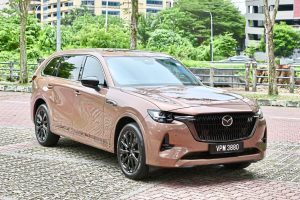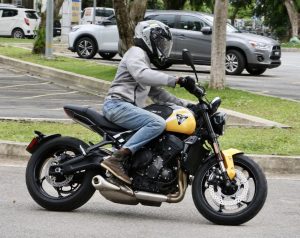STUTTGART: It's been around for 30 years, but doesn't feel like it. That's because the first Mercedes-Benz C-Class designated officially as the W202 has aged well and is still a common sight on roads.
We took a C280 model finished in a vivid green hue from the museum car park for an anniversary drive in the countryside.
To modern eyes, the dashboard switches in the W202 come across as old-fashioned and crude. The speedometer and climate control displays are the only digital features of this car's operating concept.
But once the C280 is on the road, the difference between this model and the current C-Class are not that great.

After all, the six-cylinder engine under the bonnet produces an impressive 142 kW/193 hp from a displacement of 2.8 litres. It also has only 1,490kg of weight to haul. A torque output of 270 Nm is enough for a sprint time of 9.0 seconds and a top speed of 230kph, which is still respectable today.
This youthful-looking old-timer leaves the driver in no doubt that it can match those benchmarks today. But this classic has no need to prove its mettle - respect for its venerable age forbids it.
The "navigation" in the form of an old school printed map points us away from the heart of Stuttgart, one of Germany's automobile hubs and home to Mercedes, toward the Swabian Alb region via quieter, secondary roads.

The route leads to Haus Lämmerbuckel, a functionally-chic training centre dating back to the 1980s where Mercedes instructs its managers until this day. Three decades ago, the high-end brand presented the C-Class to the world here in 1993.
This was a remarkable move at a time when Mercedes tended to make a name for itself with PR stunts, like renting five-star hotels for a media entourage or flying new cars to New York by helicopter in a glass container in order to attract maximum attention.
The C-Class's vault-like predecessor, which was sold as the 190 (W201) but went down in history as the "Baby Benz," was a bestseller because it introduced Mercedes-Benz motoring to less affluent buyers.
But Mercedes was not really doing well in the spring of 1993. For the first time, the company was overtaken by rival BMW in terms of sales and there was even talk - previously unthinkable at the brand with the three-pointed-star - of redundancies.
That is why Mercedes opted to save money - not only on presentation, but also in development, as German magazine Focus reported at the time. The Japanese, with their efficient production systems, had shown the Germans how much unnecessary money they had been spending up until then.

Mercedes cut production time by 10 to 35 hours and shortened the development window from 60 to 40 months.
Their customers benefited too: "For the first time in the history of Mercedes-Benz, we can offer a completely new model series that has been developed to be more valuable, but not more expensive, and that is priced directly in line with the predecessor model," Focus quoted board member Jürgen Hubbert as saying at the time, citing 40,825 D-marks (about $22,682 today) as the starting price.
There were other innovations too, according to Mercedes Classic spokesman Frank Scheibner.
After the S-Class, the C-Class was the second model series to be designated with a letter, thus establishing a new nomenclature that was transferred to the mid-range E-Class just a few months later. It lasted until it was watered down a few years ago with the introduction of the first EQ models.
The press was full of praise and the C-Class sold briskly - first the saloon version and from 1996 the spacious estate as well.
According to official Mercedes statistics, a total of 1.9 million units of the C-Class were sold by the time of the generation change in 2001.
Admittedly, the saloon came out amid tough economic times and the thriftiness later backfired.

From 1999 to 2003 there were frequent reports of rust appearing on door bottoms, the bumpers and the wheel arches of C-Class limos and some rusty models are still doing the rounds today.
Mercedes cars are renowned for build quality and critics said too many corners had been cut compared to the car it replaced.
Such gremlins did not prevent the brand from embarking on an ambitious sports programme.
Mercedes-Benz forged an alliance with then still independent racing team AMG, which added a supercharger to the six-cylinder (206 kW/280 hp). The resulting C36 wrote the first chapter of a success story that continues to this day.
The C-Class also had a V8 engine squeezed under its bonnet in the C43 and competed as a racing car in the German Touring Car Championship.
But the fascination has largely faded, says Frank Wilke of market observer Classic Analytics: "The C-Class is so overshadowed by its predecessor, the W201, that you hardly notice it any more."
The 190 was known by the nickname "Baby Benz" even before its premiere. For years it had been chic to drive a smaller 190 and the model had prepared the successful entry into a new vehicle class for Mercedes.
But with the C-Class, the brand never managed to generate the same kind of hype, says Wilke, with a nod to the quality problems suffered by Mercedes in the late 1990s and early 2000s.
"Like any old Mercedes, the C-Class has its fans, but you can't say there is general enthusiasm for it," says Wilke.
Current market prices reflect this: Even a rapid C36 is valued at only €18,000 (RM92,000) by Classic Analytics.
Meanwhile, a bread-and-butter C230 is listed at €6,000 (RM31,000). This makes the C-Class unsuitable as a collector's item but affordable and also suitable as a daily driver.
Cars that have survived to this day tend to be of good quality and feel more contemporary to drive than they actually are, says the expert.












